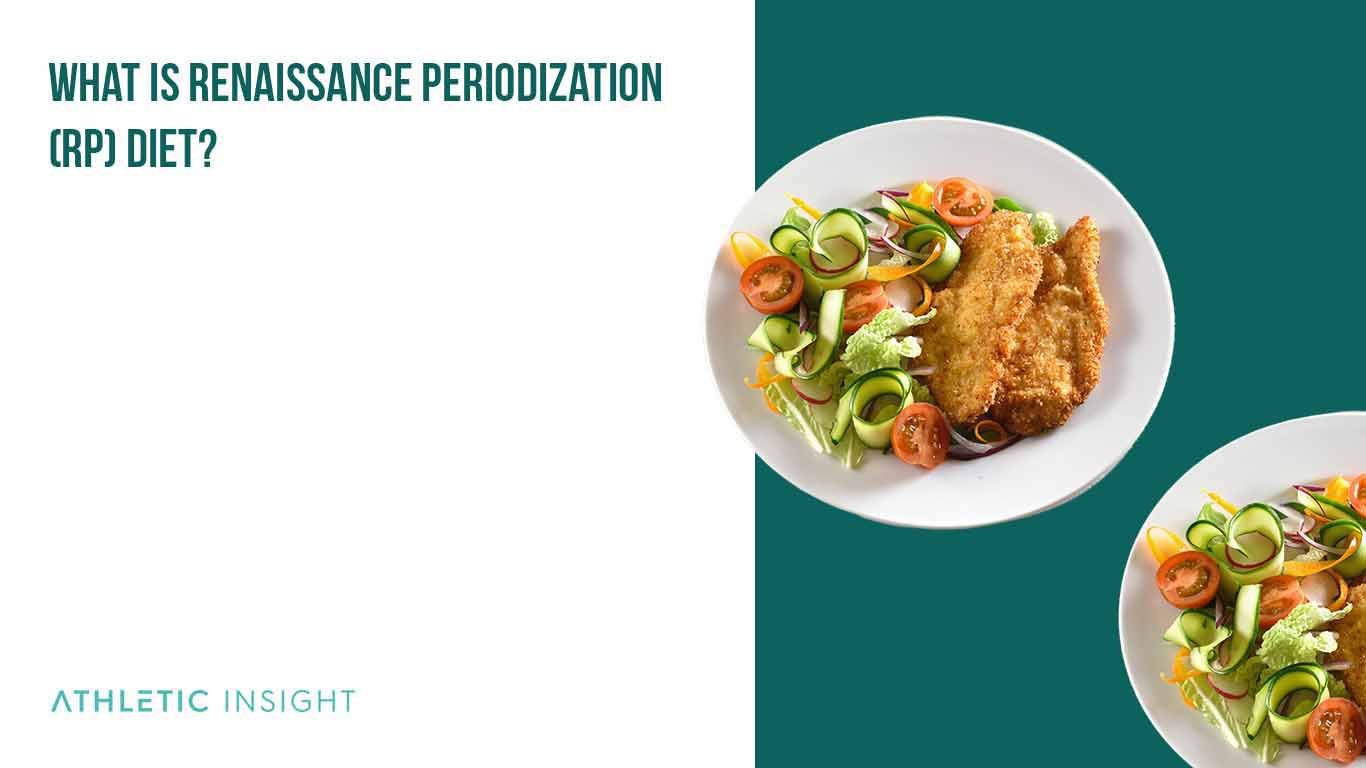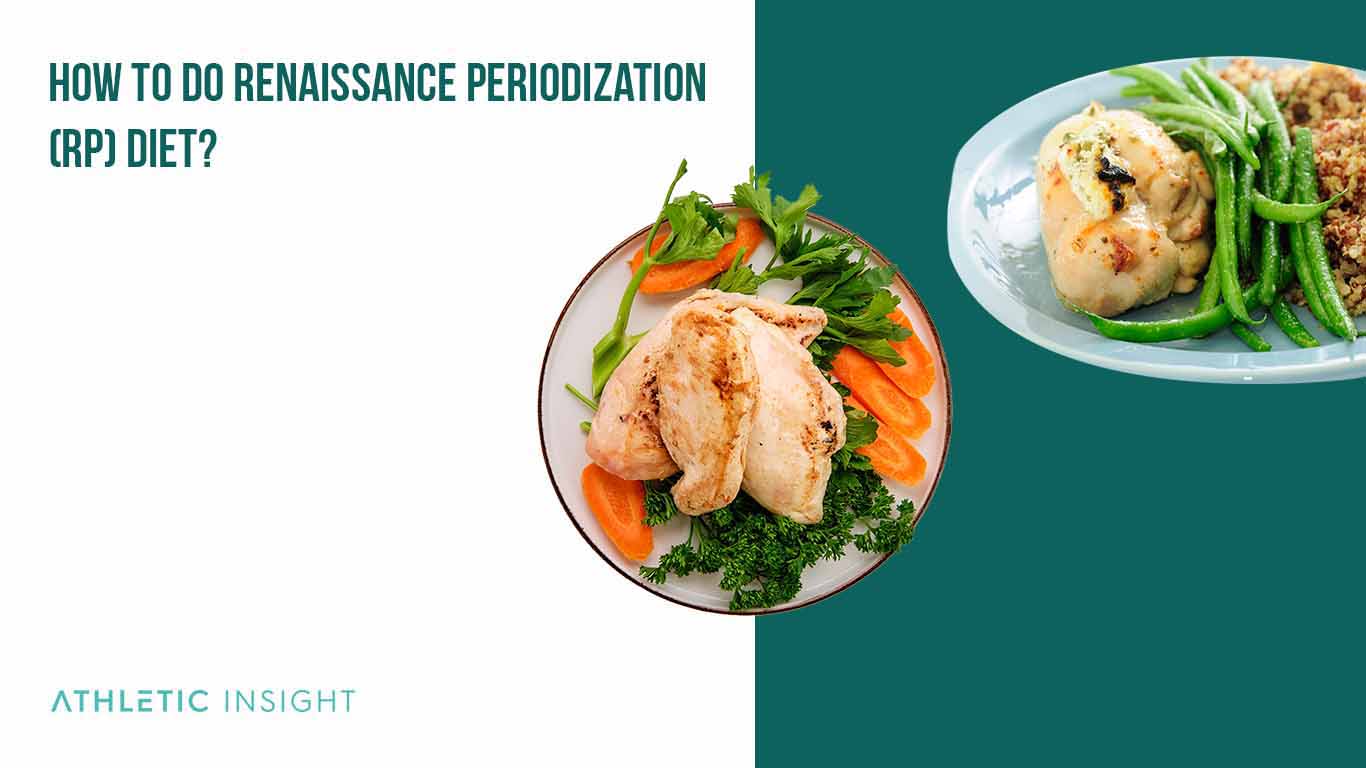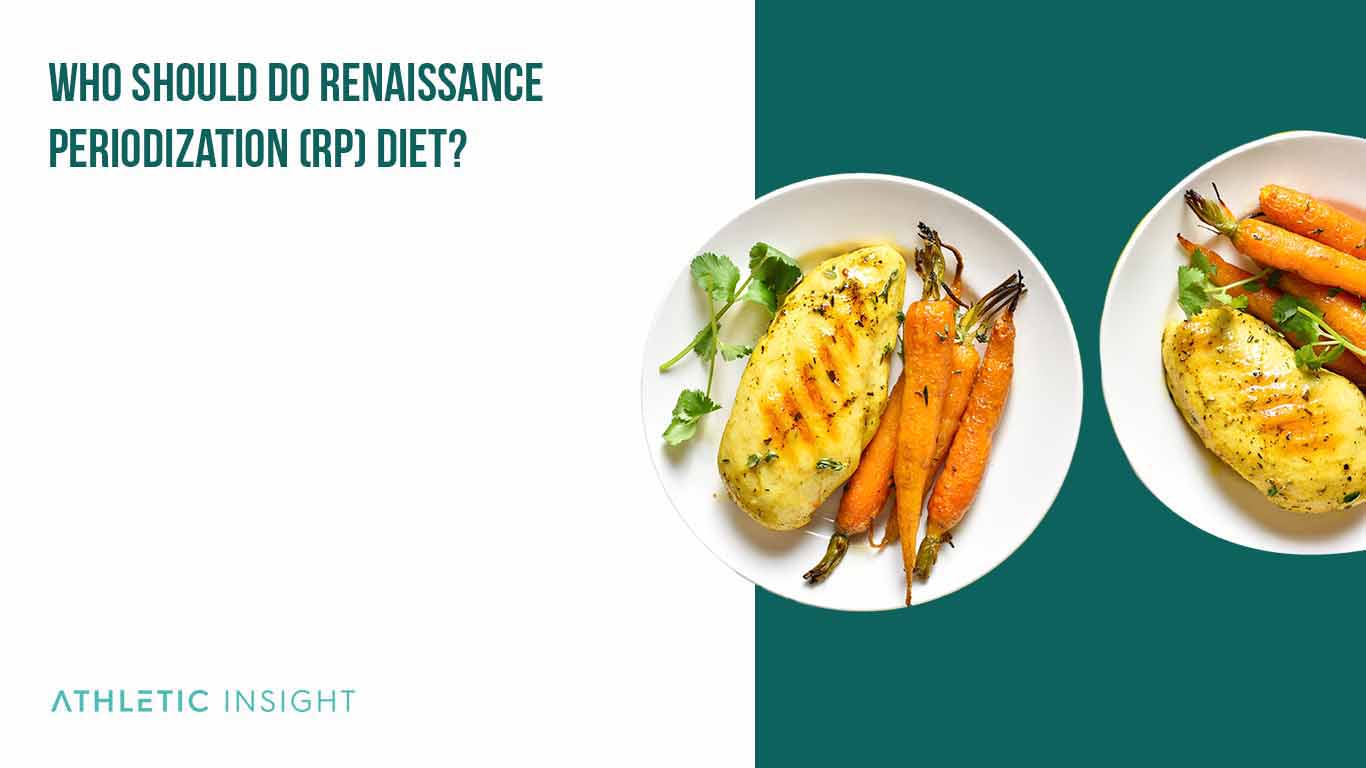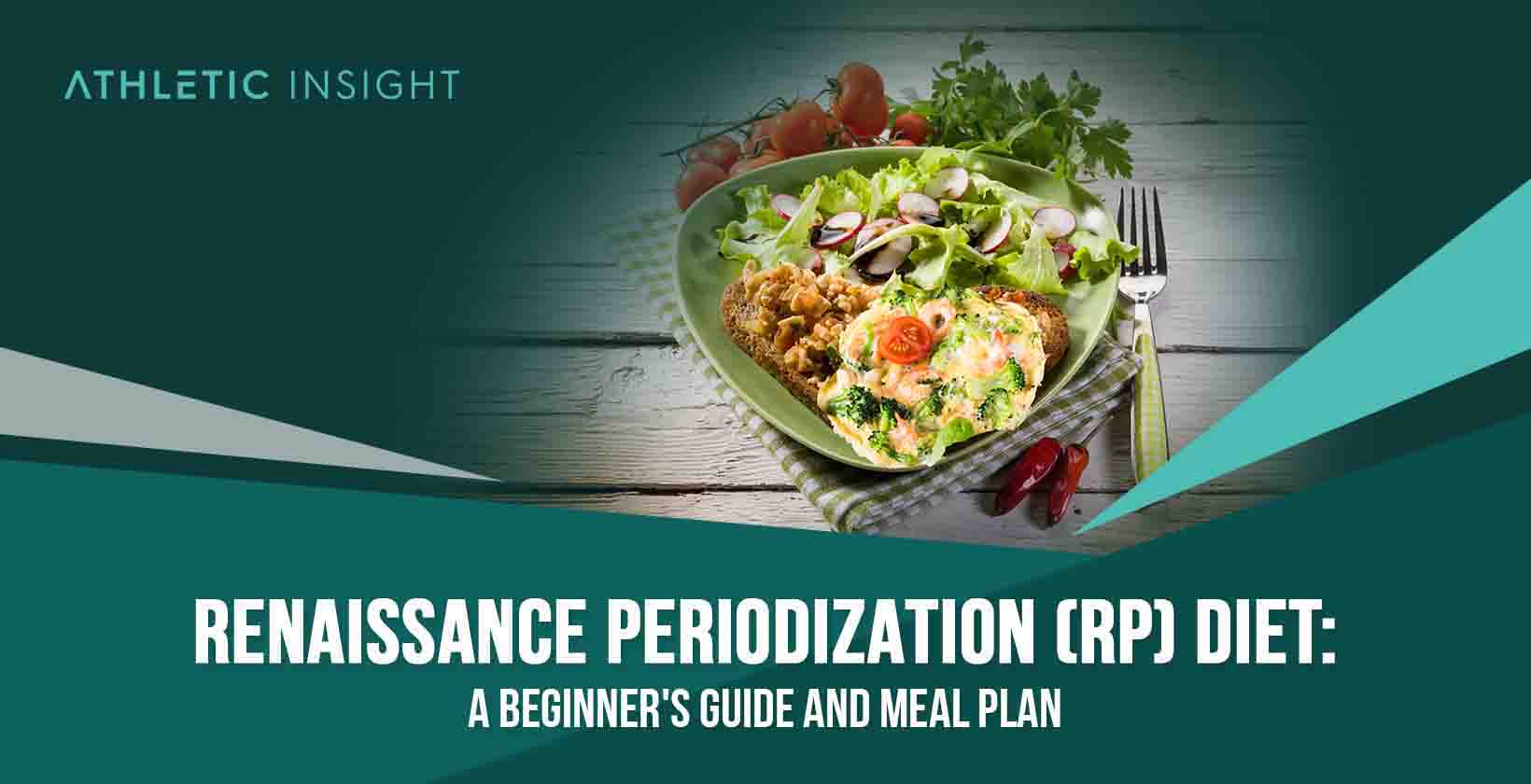Renaissance Periodization (RP) is a diet program that uses a scientifically formulated approach to help individuals achieve health and fitness goals. The program focuses on macronutrient and calorie control, nutrient timing, and food quality.
The Renaissance Periodization diet involves calculating daily calorie, protein, carbohydrate, and fat needs. The program provides a customized meal plan that specifies the types and amounts of foods to eat at each meal and snack, including the optimal timing of meals.
The Renaissance Periodization diet emphasizes consuming high-quality, nutrient-dense foods such as lean proteins, fruits, vegetables, whole grains, and healthy fats while minimizing processed and refined foods, added sugars, and unhealthy fats.
What Is a Renaissance Periodization (RP) Diet?
The Renaissance Periodization diet entails determining a person’s daily calorie and macronutrient requirements in light of body composition, activity level, and objectives and then offering a structured meal plan that considers all of these factors.

The Renaissance Periodization diet is grounded in several diet roots, each with its unique methodology and emphasis. These roots include the standard RP Diet Templates, RP Diet App, RP Strength, RP Endurance, and RP Diet Auto-templates, allowing individuals to tailor their nutrition plan to their specific needs.
- Renaissance Periodization Diet Templates: The foundational RP diet program provides customized meal plans based on an individual’s unique needs and goals. The RP Diet Templates offer several options, including fat loss, muscle gain, and maintenance, allowing individuals to tailor the diet to specific goals.
- Renaissance Periodization Diet App: The App offers a more user-friendly and interactive approach to the diet. It provides customized meal plans based on an individual’s needs and goals, with the added benefit of tracking and logging meals, progress, and adherence to the diet.
- Renaissance Periodization Strength: This is a diet and training program designed specifically for strength athletes, including powerlifters, weightlifters, and CrossFit athletes. The program emphasizes nutrient timing and macronutrient control to optimize strength and performance.
- Renaissance Periodization Endurance: This is a diet and training program designed for endurance athletes, including runners, cyclists, and triathletes. The program emphasizes nutrient timing and carbohydrate intake to optimize endurance and performance.
- Renaissance Periodization Diet Auto-templates: RP Diet Auto-templates is a more automated version of the RP Diet Templates, which provide customized meal plans based on an individual’s goals and preferences, with the added convenience of auto-updating based on progress and feedback.
The Renaissance Periodization diet is a comprehensive program to help individuals achieve health, fitness, and performance goals. The diet offers numerous benefits such as the following.
- Improved body composition: The diet helps individuals achieve desired goals, whether losing body fat or gaining muscle mass.
- Enhanced athletic performance: This diet optimizes performance by providing the right balance of macronutrients at times when the body needs it the most.
- Increased energy levels: By emphasizing nutrient-dense, whole foods, the RP diet can help to improve energy levels and reduce fatigue.
- Better health outcomes: The diet promotes a balanced intake of essential nutrients, including fiber, vitamins, and minerals, which can improve overall health and reduce the risk of chronic diseases.
- Improved adherence: By providing a structured meal plan tailored to an individual’s needs and goals, the RP diet can improve adherence and help individuals stick to dietary goals over the long term.
The diet provides a structured, evidence-based approach to nutrition for an individual’s unique needs and goals. This diet involves several vital principles.
- Macronutrient control: The RP diet focuses on balancing macronutrients, including protein, carbohydrates, and fat, in a way that supports an individual’s goals.
- Nutrient timing: The emphasizes the importance of timing meals around training and competition to optimize physical performance and recovery.
- Food quality: This diet emphasizes the consumption of nutrient-dense, whole foods while minimizing the intake of processed and refined foods, added sugars, and unhealthy fats.
The Renaissance Periodization diet is founded on scientific research and is regularly updated to ensure its efficacy. With several different diet types to choose from, each with a distinct approach and focus, individuals can customize their nutrition plan based on their goals and preferences.
How Does Renaissance Periodization (RP) Diet Work?
The Renaissance Periodization diet works by providing a structured approach to nutrition and dieting. Here are some of the ways the diet may benefit different organs and systems in the body.
- Digestive System: This diet emphasizes the consumption of nutrient-dense, whole foods which can help improve digestive function and reduce inflammation in the gut.
- Liver: The RP diet emphasizes the consumption of whole foods and minimizes intake of processed and refined foods, which can reduce the burden on the liver and improve its function.
- Kidneys: The diet is not high in protein but emphasizes adequate protein intake to support muscle growth and repair. For individuals with pre-existing kidney issues, working with a qualified health professional to determine appropriate protein intake is crucial.
- Muscles: This diet supports muscle growth and repairs through adequate protein intake and nutrient timing around training or competition.
- Cardiovascular System: The RP diet can help improve cardiovascular health by promoting weight loss, reducing inflammation, and improving blood sugar control.
- Endocrine System: The diet can impact hormone levels and function by supporting a healthy weight and reducing inflammation.
It is important to note that the specific impact of the RP diet app on different organs and systems can vary depending on an individual’s unique needs and goals.
What Are the Health Benefits of the Renaissance Periodization (RP) Diet?
The Renaissance Periodization diet template can offer a range of health benefits, from improved body composition to better overall health and reduced risk of chronic diseases.
- Customized Approach To Nutrition: RP diet templates provide a structure to help individuals achieve and maintain health and improve athletic performance.
- Improve Overall Health: By emphasizing the consumption of nutrient-dense, whole foods and minimizing the intake of processed and refined foods.
- Improved Physical and Mental Health: Following the diet templates can help improve digestive function, reduce inflammation, and support healthy hormone levels and function.
- Performing the Best: Following the diet templates can help optimize energy levels, reduce fatigue, and improve mental clarity and focus.
What Are the Health Risks of Renaissance Periodization (RP) Diet?
The Renaissance Periodization diet has its share of potential health risks, particularly if not followed properly. While the diet’s recipes can provide a structured approach to nutrition and dieting, it is vital to consider the potential negative consequences.
- Limitations: Renaissance Periodization diet recipes can be restrictive and may lead to nutrient deficiencies if not properly planned and monitored.
- Assorted Challenges: Following the diet for an extended period can be challenging and may lead to disordered eating behaviors, such as obsessive tracking and restriction of food intake.
- Not For All: Renaissance Periodization diet recipes may not be suitable for everyone, particularly those with underlying health conditions or who are pregnant or breastfeeding.
- Unsustainable: The diet may not be sustainable long-term for some individuals, and transitioning back to a regular diet after following the plan may lead to weight regain or other adverse health consequences.
How To Do Renaissance Periodization (RP) Diet?
to do the Renaissance Periodization (RP) Diet, there are a few important steps to follow. These steps include creating goals, incorporating the model, monitoring progress and being patient.

- Create Goals: It is crucial to set clear goals for body composition and choose the appropriate RP diet template that aligns with these goals. The templates can be customized to fit different time frames and needs, whether it’s short-term weight loss or long-term sustainable healthy eating.
- Incorporate the Model: Following the RP diet template involves tracking macronutrient intake and consuming nutrient-dense whole foods. Rather than focusing solely on calorie intake, this diet prioritizes macronutrient timing and distribution to optimize results.
- Monitor Progress: Monitoring progress is essential to ensure continued progress toward all goals. Using RP diet reviews can help individuals adjust their macronutrient intake as needed and ensure they stay on track.
- Be Patient: Consistency and patience are key when following the diet. It’s important to trust the process and seek guidance from a registered dietitian or RP coach when needed.
Following the Renaissance Periodization diet involves setting clear goals, choosing the right template, tracking macronutrient intake, consuming nutrient-dense whole foods, monitoring progress, and staying consistent and patient to see results over time. Keep in mind that it is important to seek guidance from a registered dietitian or RP coach when needed.
What Are the Foods That You Can Eat While on a Renaissance Periodization (RP) Diet?
While following a Renaissance diet, the recommended foods include lean proteins, complex carbohydrates, healthy fats, fruits and vegetables.
- Lean proteins: Turkey, chicken breast, fish, tofu, lean beef, and egg whites.
- Complex carbohydrates: Quinoa, brown rice, sweet potatoes, whole-grain bread, and oats.
- Healthy fats: Nuts, Avocado, seeds, olive oil, and nut butter.
- Fruits and vegetables: Broccoli, spinach, berries, apples, oranges, and bell peppers.
The Renaissance Periodization diet app reviews can provide specific guidance on food choices and portion sizes.
What Are the Foods That You Should Avoid While on a Renaissance Periodization (RP) Diet?
Foods that should be avoided while following a Renaissance diet include processed foods, high-fat foods, simple carbohydrates, and alcohol.
- Processed foods: Highly processed snacks, sweets, and packaged foods.
- High-fat foods: Fried foods, fatty meats, and high-fat dairy products.
- Simple carbohydrates: Candy, soda, white bread, and sugary cereals.
- Alcohol: Beer, wine, and spirits.
The Renaissance Periodization diet templates PDF free format may provide more detailed information on foods to avoid and recommended alternatives. However, consulting with a registered dietitian or RP coach for individualized guidance is recommended.
Who Should Do Renaissance Periodization (RP) Diet?
The diet can benefit anyone looking to improve body composition, athletic performance, or overall health. It is trendy among athletes who use RP Strength Diet templates to meet specific goals.

What Is a Sample Renaissance Periodization (RP) Diet Plan?
Here is a brief sample weekly menu plan for the Renaissance Periodization diet.
- Monday:
- Breakfast: Greek yogurt with berries and almonds
- Lunch: Grilled chicken breast with roasted vegetables
- Dinner: Baked salmon with quinoa and steamed broccoli
- Tuesday:
- Breakfast: Scrambled eggs with spinach and whole-grain toast
- Lunch: Turkey and avocado wrap with mixed greens
- Dinner: Lean beef stir-fry with brown rice and mixed vegetables
- Wednesday:
- Breakfast: Oatmeal with banana and peanut butter
- Lunch: Tuna salad with mixed greens and whole-grain crackers
- Dinner: Grilled tofu with sweet potato wedges and green beans
- Thursday:
- Breakfast: Protein smoothie with mixed berries and almond milk
- Lunch: Chicken salad with mixed greens and whole-grain pita bread
- Dinner: Turkey meatballs with marinara sauce and zucchini noodles
- Friday:
- Breakfast: Cottage cheese with pineapple and walnuts
- Lunch: Grilled shrimp with quinoa and roasted vegetables
- Dinner: Baked chicken breast with sweet potato mash and steamed asparagus
- Saturday:
- Breakfast: Breakfast burrito with scrambled eggs, black beans, and salsa
- Lunch: Grilled portobello mushroom burger with sweet potato fries
- Dinner: Baked cod with mixed vegetables and quinoa
- Sunday:
- Breakfast: Protein pancakes with mixed berries and maple syrup
- Lunch: Lentil soup with mixed greens and whole-grain bread
- Dinner: Grilled steak with roasted potatoes and green beans
This menu is just a sample, and RP diet coaching can provide personalized guidance on meal planning and macronutrient targets based on individual needs and goals.
What Are the Best Recipes for Renaissance Periodization (RP) Diet?
Here are five Renaissance Periodization diet-friendly recipes:
- Grilled chicken with mixed vegetables: Season chicken breasts with salt and pepper, grill until cooked, and serve with a mix of roasted or steamed vegetables such as bell peppers, zucchini, and broccoli.
- Greek yogurt with berries and almonds: Mix plain Greek yogurt with fresh berries, sprinkle with almonds, and a drizzle of honey.
- Cauliflower fried rice with shrimp: Pulse cauliflower in a food processor until it reaches a rice-like consistency, sauté with garlic and onions, add in cooked shrimp and mixed vegetables, and finish with soy sauce.
- Turkey and Sweet Potato Chili: In a large pot, cook the ground turkey and onion until the turkey is browned and the onion is soft. Add the sweet potato, black beans, diced tomatoes, chili powder, and cumin. Season with salt and pepper. Simmer until the sweet potato is tender.
- Grilled Salmon with Broccoli and Quinoa: Brush the salmon with olive oil and season with salt and pepper. Grill until cooked through. Steam the broccoli until tender. Serve the salmon and broccoli over a bed of cooked quinoa.
Working with a Renaissance Periodization diet coach can also provide personalized recipe recommendations based on individual dietary needs and preferences.
What Are the Facts About Renaissance Periodization (RP) Diet?
- The Renaissance Periodization diet is a flexible approach that aims to optimize nutrient intake while allowing for various foods.
- To achieve specific goals, the RP diet emphasizes tracking macronutrient intake, including protein, carbohydrates, and fats.
- The Renaissance Periodization diet provides guidelines for meal timing and frequency and a recommended list of foods that includes lean proteins, whole grains, vegetables, and fruits.
- The Renaissance Periodization diet has several variations, including fat loss, muscle gain, and maintenance templates.
Is Renaissance Periodization (RP) Diet Considered a Healthy Diet?
Yes, the Renaissance Periodization diet is generally healthy because it focuses on nutrient-dense foods and emphasizes proper macronutrient intake. Many people, including those in RP diet reviews, female and otherwise, have reported positive results regarding improved body composition, energy levels, and overall health.
Is Renaissance Periodization (RP) Diet Expensive?
Yes, the Renaissance Periodization diet is typically more costly than one’s previous food expenses due to factors such as the specific RP diet plan, access to coaching, and food choices. Nonetheless, many individuals have reported significant health and fitness benefits, and before-and-after photos demonstrate notable changes in body composition, making the investment worthwhile.
How Much Exercise Should You Do in the RP Diet?
The Renaissance Periodization diet is to be used in conjunction with an exercise program. The recommendation is to engage in resistance training exercises at least three times per week.
Cardiovascular exercise can also be incorporated, focusing on moderate-intensity steady-state (MISS) and high-intensity interval training (HIIT) for optimal results. Seeking guidance from a qualified RP diet coach can help create a personalized exercise plan.
What Does a Renaissance Periodization (RP) Diet Template PDF Involve?
The Renaissance Periodization diet involves specific meal templates for various training phases. The RP diet templates are PDF and can be purchased online.
The Renaissance Periodization diet template PDFs typically include a detailed guide on using them and instructions on calculating daily caloric needs. The templates provide meal options for various training phases.
Several book options are available for those interested in the diet, including “The Renaissance Diet” and “RP Scientific Principles.” Both books provide detailed information on the science behind the RP diet and practical advice for implementing the diet into daily life.
How To Find 3D Renaissance Periodization (RP) Diet Printable Plan?
There are several ways to find a 3D Renaissance Periodization (RP) Diet printable plan. One option is to search online for diet results, RP diet weight loss, and RP strength diet reviews and look for websites or blogs that offer printable templates. Another option is to purchase an RP diet book or program, which may include printable plans or access to online resources.



